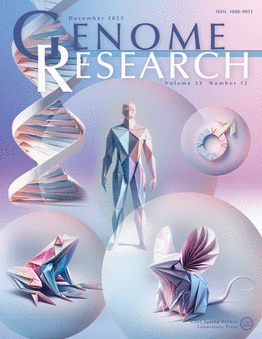Chimeric mitochondrial RNA transcripts predict mitochondrial genome deletion mutations in mitochondrial genetic diseases and aging
IF 5.5
2区 生物学
Q1 BIOCHEMISTRY & MOLECULAR BIOLOGY
引用次数: 0
Abstract
While it is well understood that mitochondrial DNA (mtDNA) deletion mutations cause incurable diseases and contribute to aging, little is known about the transcriptional products that arise from these DNA structural variants. We hypothesized that mitochondrial genomes containing deletion mutations express chimeric mitochondrial RNAs. To test this, we analyzed human and rat RNA sequencing data to identify, quantitate, and characterize chimeric mitochondrial RNAs. We observed increased chimeric mitochondrial RNA frequency in samples from patients with mitochondrial genetic diseases and in samples from aged humans. The spectrum of chimeric mitochondrial transcripts reflected the known pattern of mtDNA deletion mutations. To test the hypothesis that mtDNA deletions induce chimeric RNA transcripts, we treated 18 mo and 34 mo rats with guanidinopropionic acid to induce high levels of skeletal muscle mtDNA deletion mutations. With mtDNA deletion induction, we demonstrate that the chimeric mitochondrial transcript frequency also increased and correlated strongly with an orthogonal DNA-based mutation assay performed on identical samples. Further, we show that the frequency of chimeric mitochondrial transcripts predicts expression of both nuclear and mitochondrial genes central to mitochondrial function, demonstrating the utility of these events as metrics of age-induced metabolic change. Mapping and quantitation of chimeric mitochondrial RNAs provides an accessible, orthogonal approach to DNA-based mutation assays, offers a potential method for identifying mitochondrial pathology in widely accessible datasets, and opens a new area of study in mitochondrial genetics and transcriptomics.嵌合线粒体 RNA 转录本预测线粒体遗传疾病和衰老中的线粒体基因组缺失突变
尽管线粒体 DNA(mtDNA)缺失突变会导致无法治愈的疾病并导致衰老,但人们对这些 DNA 结构变异产生的转录产物却知之甚少。我们假设,含有缺失突变的线粒体基因组会表达嵌合线粒体 RNA。为了验证这一假设,我们分析了人类和大鼠的 RNA 测序数据,以识别、定量和描述嵌合线粒体 RNA。我们观察到,在线粒体遗传疾病患者的样本和老年人的样本中,嵌合线粒体 RNA 的频率有所增加。嵌合线粒体转录本的频谱反映了已知的 mtDNA 缺失突变模式。为了验证 mtDNA 缺失会诱导嵌合 RNA 转录本的假设,我们用胍基丙酸处理了 18 个月和 34 个月的大鼠,以诱导高水平的骨骼肌 mtDNA 缺失突变。随着 mtDNA 缺失的诱导,我们发现嵌合线粒体转录本的频率也在增加,并且与在相同样本上进行的基于 DNA 的正交突变检测密切相关。此外,我们还发现嵌合线粒体转录本的频率可以预测线粒体功能的核心核基因和线粒体基因的表达情况,从而证明了这些事件作为年龄诱导的代谢变化指标的实用性。嵌合线粒体 RNA 的制图和定量为基于 DNA 的突变检测提供了一种便捷、正交的方法,为在广泛获取的数据集中识别线粒体病理学提供了一种潜在的方法,并为线粒体遗传学和转录组学的研究开辟了一个新的领域。
本文章由计算机程序翻译,如有差异,请以英文原文为准。
求助全文
约1分钟内获得全文
求助全文
来源期刊

Genome research
生物-生化与分子生物学
CiteScore
12.40
自引率
1.40%
发文量
140
审稿时长
6 months
期刊介绍:
Launched in 1995, Genome Research is an international, continuously published, peer-reviewed journal that focuses on research that provides novel insights into the genome biology of all organisms, including advances in genomic medicine.
Among the topics considered by the journal are genome structure and function, comparative genomics, molecular evolution, genome-scale quantitative and population genetics, proteomics, epigenomics, and systems biology. The journal also features exciting gene discoveries and reports of cutting-edge computational biology and high-throughput methodologies.
New data in these areas are published as research papers, or methods and resource reports that provide novel information on technologies or tools that will be of interest to a broad readership. Complete data sets are presented electronically on the journal''s web site where appropriate. The journal also provides Reviews, Perspectives, and Insight/Outlook articles, which present commentary on the latest advances published both here and elsewhere, placing such progress in its broader biological context.
 求助内容:
求助内容: 应助结果提醒方式:
应助结果提醒方式:


